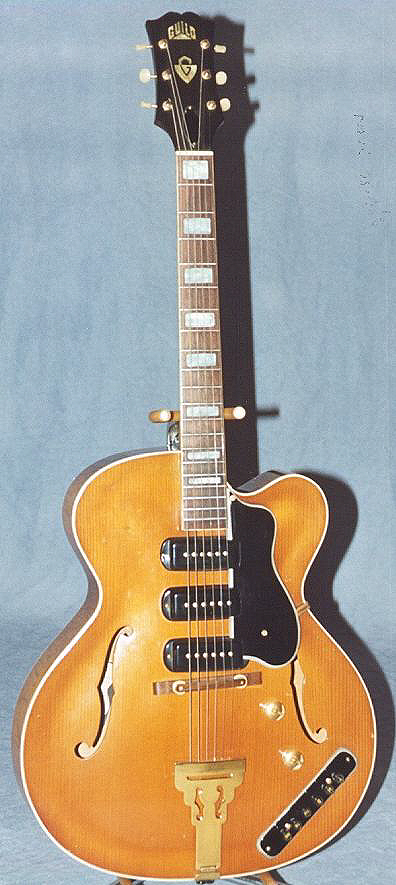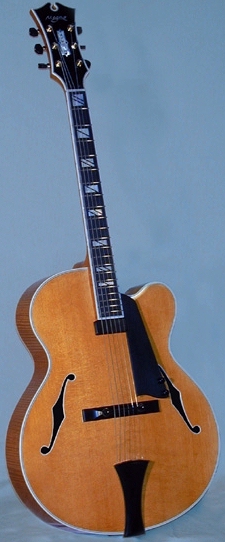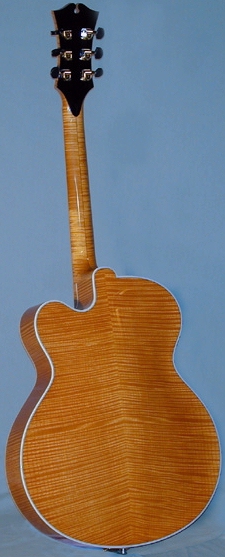Archtops: Not Just for Jazz!
By Greg Gagliano
Copyright 2000, 20th
Century Guitar Magazine.
If you like archtops, you owe it to yourself to go to the annual Classic
American Guitar Show in Long Island to see a multitude of models ranging
from vintage to cutting edge post-modern designs. I like archtops.
I think they are works of art. Even if I didn’t play guitar, I’d like
them just because I think they are beautiful to look at. They can be
sexy (Gretsch 6120) or classy (Gibson L-5) or cheesy (pick any budget Kay
or Harmony model) or regal (Epiphone Emperor) or even a bit eccentric (Guild
X-350). Most importantly, they are not just for jazz.

Sure, we know plenty of rockers have used archtops to good effect.
George Harrison has his Gretsch 6122 and 6117, Brian Setzer and Duane Eddy
have their Gretsch 6120s, Dave Gonzalez has his Guild X-550, Steve Howe
has his Gibson ES-175, and Ted Nugent has his Gibson Byrdland. But
these are considered anomalies in the archtop world a.k.a. the jazz world.
The “mostly jazz” attitude surrounding archtops is likely a by-product of
archtops from the olden days. These guitars were voiced for jazz artists,
specifically big bands and swing bands. They generally had a loud, midrangey
tone that was perfect for cutting through the mix for the comping guitarist.
The electric archtops that followed were merely extensions of that idea and
allowed jazzers to solo.
But the archtops from today’s builders are no longer constructed or voiced
to play only jazz. Rather, they are much more versatile. That’s
not to say they don’t sound good for jazz; on the contrary, they still excel
in this area and are considered de rigeur. Jazz pundits might poo-poo
me on “wasting” a perfectly good archtop on anything but jazz. I don’t
think these players ever understood rock and roll to be anything but simple,
unrefined, and loud compared to jazz anyway, so there’s no trying to persuade
them otherwise. Besides, we already know that electric archtops sound
good for rock… and western swing… and blues.
But can an acoustic archtop really ever be as versatile as, say, a flattop
acoustic guitar? I believe so, especially the modern archtops.
Very few current luthiers build archtops with old-style voicing. Sure,
some may have a model or two with a vintage voice (or will custom build one
to suit), but most of the current designs have a more open sound. The
frequency response tends to be more even from top to bottom without the traditional
honking midrange. What’s really cool is that a lot of these “open” sounding
archtops look rather traditional. You don’t need to buy an avante gard
design to get post-modern tone!

The key here is construction technique and materials. You’ll find
that the majority of current archtops use X-braced tops. Now why would
they do that since Gibson abandoned that idea in the late 1930s? In
general, X-braced guitars are a little warmer sounding at the expense of some
volume and cutting power. I say, “in general”, because a skilled luthier
can build a guitar with the voice desired using parallel or X-bracing.
Most luthiers these days are hand-selecting only the best tone woods for
their guitars. Granted, their “budget” model may not use the same super
flamey maple that their top-of-the-line models use, but remember these builders
are selecting wood for tonal quality, strength/durability, as well as aesthetics.
A good piece of tone wood that will produce great sound is key. Aesthetics
are just gingerbread, albeit very desirable. These builders are not
mass-producing guitars like Gibson and Epiphone did so many years ago.
Instead, they are finely crafting their guitars (think D’Angelico, and Stromberg)
at the rate of about one per month or less. What’s really neat is that
the current crop of builders are taking archtop building to a level never
envisioned by those early master luthiers (with the exception of D’Aquisto
who arguably started the “modernist” movement).
I don’t mean to imply that modern archtops are superior to vintage examples
or that vintage acoustic archtops are only good for swing bands. On
the contrary, some old archtops are absolutely killer for just about any style
of popular music from jazz to blues to folk. My favorite versatile archtop
of old is the Gibson L-7 from the period between 1947 to about 1952.
To date, I’ve played at least a couple dozen examples of L-7s from this era
and only one was a dog. Not bad! Also, Advanced L-7s and L-12s
with X-bracing from the late 1930s are reasonably good “all ‘rounders,” too.
But with the explosion of archtop builders (since about 1990), the modern
archtop is very tough to beat for tone, versatility and quality of materials/workmanship.
My three favorite builders are Kim Walker, Mark Campellone and Ted Megas.
They make guitars that fit my sense of aesthetics, work well with my mostly
non-jazz playing style and, most importantly, produce the tones I want to
hear. Don’t let my taste in archtops bias you. You’ll need to
play a bunch and decide for yourself what you like and don’t like.
This is of paramount importance considering the cost and potential waiting
period to have an archtop built for you.
I consider myself lucky to own a guitar from one of these fine builders,
namely, a Megas Athena. This guitar astounds me in every way possible.
Its flame maple body literally glows under the amber finish… it’s drop-dead
gorgeous. The fit and finish is absolutely first rate as exemplified
by the binding work - all but one of the binding mitered joints are impossible
to detect. It plays like an electric guitar and rarely goes out of
tune thanks to modern technology (graphite rods in the neck for extra strength
and stability).


Tonally, the guitar runs the gamut from jazz to rock with great ease.
It has great clarity and articulation. Like all archtops, the harder
you pound on it, the louder it gets while still remaining clear. Try
that on a flattop and the tone turns loud and muddy. Another trait I’ve
found in modern archtops is their sustain. Flattops sustain very well,
but archtops of old needed a lot of power to drive the top. Not so
these days as they will sustain for days (sort of). Most modern archtops
come equipped with floating pickups and this feature only adds to their versatility.
Of course, these guitars tend to be more sensitive to feedback than their
laminated top electric cousins, so amplifier placement and control settings
take on greater importance.
Strung with 12 gauge phosphor bronze strings, I use my Athena as would
use any acoustic guitar. I use it for fingerstyle playing. I
use it for blues. I use it to play acoustic versions of my favorite
rock tunes. I try my hand at jazz comping (until my hand cramps up) and
I even use it in the choir at church. This last venue really demonstrates
how well an archtop plays juxtaposed to the flattops in the group.
The tone of the Megas is very articulate and adds a lot of sparkle and power
to the mix and competes with the pipe organ as well as any guitar could.
Strung with 12 gauge pure nickel round or flatwound strings, I use my
Athena as I would any electric guitar. I use it for blues. I use it
for rock and used it to record the feedback for the opening to “I Feel Fine”.
Of course, it has superlative jazz tone when plugged into an old Ampeg jazz
amp (Everett Hull would be proud of me).
I still think it’s a bit funny that, for the most part, archtop players
are using their guitboxes for jazz. Heck, with respect to the modern
archtop’s versatility, even guitarist extraordinaire Steve Howe (an avid
archtop user) was quoted in the book, Blue Guitar: “… I could country
pick on an archtop. I don’t, but I could.” His point is well
taken, i.e. – archtops are versatile. But between you and me, I think
Mr. Howe is a bit of a coward if he doesn’t chicken pick on an archtop even
though he could. I guess when you’re a virtuoso guitarist nobody, except
perhaps another virtuoso, can call you to the mat on it. I’ll bet Peter
Frampton would chicken pick on archtop… and I’ll bet he’d sound killer, too!
If you make it to the American Guitar Show, be sure to go by the luthiers’
booths and play some of their offerings. Also, be sure to listen to
what’s being played as people take a test drive on these beauties.
I’m sure 99% of what you’ll hear is jazz licks or comping progressions.
The other 1% might be someone doing a little rockabilly or blues… or me
sawing away on the riff to Bowie’s “Hang on to Yourself” much to the horror
of the attending master builder. The point is this – musical styles
other than jazz sound terrific on archtops. Don’t be a victim of paradigm
paralysis. Telecasters aren’t just for country music and archtops aren’t
just for jazz.
About the Author: Greg Gagliano, an archtop enthusiast, was quoted
as saying “I would chicken pick on an archtop if I knew how. I would
if I could, but I can’t so I won't.”
Back to GGJaguar's
Bibliography



